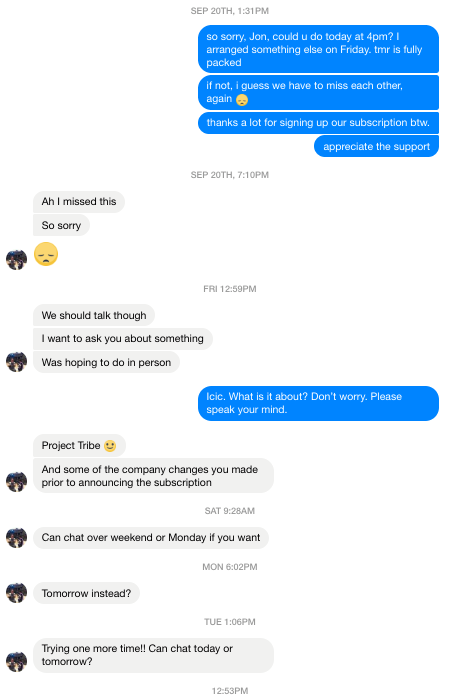TechCrunch reporter Jon Russell recently published an article about how Tech in Asia recently laid off staff and canceled its ICO. While the article reported some facts correctly, it contains numerous errors.
Below, I’ll lay out sections of his article, and rebut them point by point.
Tech In Asia founder and CEO Willis Wee did not respond to multiple requests for comment.
This is totally false. I don’t think Jon followed the proper journalistic procedure here. We did have a conversation, but at no point has he indicated that he was seeking comment for an article. It is therefore entirely untrue that Jon gave Tech in Asia a right of reply before the article was published. Here is a screenshot of the point in the conversation where Jon asked to talk to me:

Generally, the more negative an article is about a person or organization, the more care must be taken to ensure that they have a right to reply before the article is published.
Also, journalists in a beat talk to sources for various reasons – it could just be to seek background information, to understand a development better, or to catch up. Jon did not make the context of his inquiry clear, and it was wrong of him to assume that I understood his context.
Earlier this month, media startup Tech In Asia surprised its readers when it announced plans to implement an $18 per month paywall. More expensive than packages for the Bloomberg and the Wall Street Journal, the subscription went live this week.
Where do I start? We did not surprise readers. We launched early bird signups for TIA Subscription in March this year. The call to action was placed at the bottom of every article. As such, we did not just spring this onto an unsuspecting audience.
It is also flat-out wrong to say that our package is more expensive than Bloomberg and the Wall Street Journal. Here’s a table for reference, and note that Jon used the full price as the basis for comparison:
| Tech in Asia | Bloomberg | Wall Street Journal | |
| Promotion | US$9.99 | US$9.99 | US$12 for 12 weeks, then US$19.50 thereafter |
| Full price | US$18 | US$34.99 | US$39 |

Wall Street Journal‘s pricing.

Bloomberg‘s pricing

Tech in Asia‘s pricing
(To his credit, he tweaked this part of the article.)
We believe we are priced fairly because we are a niche publication providing the most comprehensive coverage of the Asian tech ecosystem. We cover news ignored by the big publications that benefit our audience. Nonetheless, we will listen to our readers and make adjustments to provide the best value.
Two sources told TechCrunch that morale of the remaining staff was crushed when members of the management ‘flaunted’ the fruits of their wealth on social media just days after firing large portions of the team.
Morale was down for sure because of the layoffs. But morale is good now. We bounced back quickly. The remaining team members are fighters. Our policies are working, and we are a lot more stable financially.
Some social media updates posted to the internet that upset departing staff members included a photo of Rolex, the view of a villa on a weekend trip to Bali, and an expensive sushi dinner bill.
The vague reporting here insinuates that Tech in Asia management (in other words, myself and the CXO team) pay ourselves extravagantly at the expense of the company. Nothing can be further from the truth. Our salaries are in line with market rates, our offices are not renovated lavishly, and I dress simply. Also, there’s nothing wrong with members of the team treating themselves to something nice using their very average salaries, and we are surprised that Jon chose to include this detail in his report without finding out more. If TIA staff buys an HDB flat (public apartment in Singapore) and posts about it on social media, will Jon report about it, too?
“There were signs of trouble earlier in 2017 for the company. Tech in Asia laid off most of its India-based team in early 2017 and ended its events business in that country. Those decisions impacted its event business, which a source said saw total revenue drop by more than 50 percent.
I don’t know where they got that from but it’s clearly wrong. Our latest annualized revenue is up more than 20 percent year-on-year. And we expect to do even better as the year closes.
Tech in Asia’s management team told all staff in June that its runway, which was thought to be shored up by the November deal, had gone from a solid-looking 81 months to just 14 months. Management claimed that a change in financial calculations caused the difference and employees were reassured that their jobs were safe. One month later, however, the company began shedding staff in an effort to cut costs, reversing a hiring spree it launched in January, according to sources.
There isn’t a change in financial calculations. We were piling up on labor and operating costs, therefore, increasing burn and shortening runway.
The same report was shared with shareholders and our team members every month. The report includes full P/L, runway, and burn rate figures. We are always open to questions. Questions were asked about how we calculate burn. But there were no questions about job security.
The decision and the execution of the layoffs were swift because dragging it out wouldn’t have helped. We closed down seven projects that weren’t working and took time to explain our decision in a company-wide town hall meeting. The layoffs were executed within a week – as fast as we could to ensure that we communicated swiftly and transparently.
We concluded funding more than a year ago. After the layoffs, we have 25 months of runway left, which is more than what many startups have. While we certainly could have done better, I believe we have taken the responsible path to ensure that the company and team can continue serving the mission.
A shift to community content, with fewer ‘original’ reporting and journalism pieces also cut into company performance. Internal data seen by TechCrunch shows that monthly active users on the site were down 31 percent year-on-year in Q2 2018 — reaching 1.84 million — while total pageviews slipped by one-third, too.
Actually, the decline in users in Q2 coincided with our increased focus on quality content. We took our time to add depth to each article, and also stopped republishing pieces from various sources. That led to a drop in the overall number of articles (though each piece was unique), but our user base declined significantly as well.
In Q3, we tried to find a middle ground, supplementing original reporting with republished content, and as such our monthly users grew by 24 percent on average over Q2. As we move towards the subscription model, we anticipate that our user count will drop once more as people will get a limited number of free content each month, but at the service of generating us more revenue on a per user basis. Moving forward, we will be aligning our content strategy with what our subscribers want.
Conclusion
We do not blame Jon for wanting to report about the layoffs. In fact, we report on layoffs ourselves. However, care must be taken to ensure accuracy when reporting news that could impact a company’s internal morale and perception among investors, shareholders, and customers. We ask that Jon correct his article immediately.
Regarding the layoffs, we did what we believe was right for the business. In both good and bad times, we have been transparent to our team and shareholders.
For those who leaked information to TechCrunch, I’m all good if it makes you feel better. I’m truly sorry to the team members we let go.
We wish everyone the very best.
TechCrunch’s original article is below:
Earlier this month, media startup Tech In Asia surprised its readers when it announced plans to implement an $18 per month paywall. More expensive than packages for the Bloomberg and the Wall Street Journal, the subscription went live this week. It’s designed to make the business self-sustaining after a tricky period of business in which the company contemplated an ICO and was forced to make cutbacks to its team.
The Singapore-based company — which operates a popular blog and events business in Southeast Asia — laid off as many as one-third of its staff after it went back on a plan to raise money from an ICO, according to documents reviewed by TechCrunch and multiple people familiar with the situation.
In July, as the company scrapped its ICO plans, Tech In Asia fired 18 of its 60 employees in Singapore; one-third of its smaller employee base in Indonesia and restructured other business units after scrapping the plan to develop its own cryptocurrency. Most of the layoffs were in non-editorial business lines — like the company’s jobs division, which works with companies to pitch the Tech In Asia website as a recruitment platform. That division laid off half of its team, according to a source, while a number of reporters elected to leave the company too, as E27 reported in August.
Tech In Asia founder and CEO Willis Wee did not respond to multiple requests for comment.
While the fundraising target for the ICO wasn’t disclosed, the plan was to bring in enough new investment to extend the company’s eroding runway.
The ICO was part of ‘Project Tribe,’ a strategy to develop a decentralized platform that would allow any organization to develop online communities using a blockchain-based framework built by Tech In Asia, according to documents viewed by TechCrunch.
“Our goal is to give Tech In Asia back into the hands of the community and harness community forces to bring us closer to our mission of building and serving Asia’s tech communities,” the company wrote in one section of the whitepaper, which was never released but had been widely-circulated beyond Tech In Asia staff.
The most successful ICOs have developed decentralized systems that are often initially beneficial to the company behind the token sale, but that can, in theory, be extended to cover other businesses.
Project Tribe used that angle. Bearing some basic similarities to the Civil journalism platform, the plan was initially to host Tech In Asia’s news and community website over the next three years, before opening up to third parties by 2021.
Company-wide Slack messages seen by TechCrunch show that it was discarded after the management team balked at the risk behind the move. They told staff their concern that token economics, pleasing retail investors and legal uncertainties would all distract from the core business. That reversal was taken despite “significant” investment resources and dozens of staff being allocated to develop the concept and whitepaper over a number of months.
From funding to cutbacks
It wasn’t so long ago that Tech In Asia was the toast of Asia’s media community.
The startup — which launched in 2010 — brought in $6.6 million in fresh funding last November in a round led by Korean investor Hanwha.
In the ensuing six months, after watching annual revenue drop thanks in part to a dramatic decline in its events business, the Tech In Asia leadership caught crypto fever and decided to venture into the new world of ICOs.
There were signs of trouble earlier in 2017 for the company. Tech in Asia laid off most of its India-based team in early 2017 and ended its events business in that country. Those decisions impacted its event business, which a source said saw total revenue drop by more than 50 percent.
A shift to community content, with fewer ‘original’ reporting and journalism pieces also cut into company performance. Internal data seen by TechCrunch shows that monthly active users on the site were down 31 percent year-on-year in Q2 2018 — reaching 1.84 million — while total pageviews slipped by one-third, too.
Tech In Asia’s management team told all staff in June that its runway, which was thought to be shored up by the November deal, had gone from a solid-looking 81 months to just 14 months. Management claimed that a change in financial calculations caused the difference and employees were reassured that their jobs were safe.
One month later, however, the company began shedding staff in an effort to cut costs, reversing a hiring spree it launched in January, according to sources.
Two sources told TechCrunch that morale of the remaining staff was crushed when members of the management ‘flaunted’ the fruits of their wealth on social media just days after firing large portions of the team. Some social media updates posted to the internet that upset departing staff members included a photo of Rolex, the view of a villa on a weekend trip to Bali, and an expensive sushi dinner bill.
With the company facing a straitened financial situation, if Tech In Asia tries to raise money again it’ll have some explaining to do to potential investors.
The business grossed SG$3.37 million (US$2.47 million) for the first six months of the year. Annualized, that would represent a 15 percent drop on 2017’s revenue, and Tech In Asia is still losing money. It recorded a net loss of SG$1.43 million (US$1.05 million) for the first half of 2018, according to internal data. That’s an average monthly burn rate of SG$0.23 million, or US$0.17 million.
Nonetheless, Wee — the Tech In Asia CEO — is hopeful that the subscription model pivot can make Tech In Asia sustainable in the long run.
“As you probably know, our business model has been built around events and advertising. While these have kept our business going, we are still working towards becoming profitable. Why is achieving this important? Because the only way we can be better at serving Asia’s tech ecosystem is if we have more resources and a consistent income stream,” he wrote when announcing the subscription package.
Full disclosure: I bought an annual subscription to Tech In Asia at the early bird discount rate being offered right now. That doesn’t impact my coverage of this story — I support a number of media businesses via subscription packages.
Tech in Asia
Tech in Asia is the largest English-language technology media company that focuses on Asia. From the latest news to the hottest trends and the boldest startups to the strongest titans, we cover everything tech in the region. Our goal is to build and serve Asia’s tech and startup community.
- Location
- Singapore
- Founded
- 2011
- Employees
- 51 – 200
- Website
- www.techinasia.com
- Latest Funding
- M&A
- Hiring
- 6 positions
Recommended reads
 Embattled unicorn eFishery accelerates mass layoffs
Embattled unicorn eFishery accelerates mass layoffs EFishery ex-CEO calls billion-rupiah salary claim ‘untrue’
EFishery ex-CEO calls billion-rupiah salary claim ‘untrue’ 60/40 Podcast: Trump’s tariffs in Asia, TSMC in the US, and more
60/40 Podcast: Trump’s tariffs in Asia, TSMC in the US, and more Coinbase to let go of 950 staff amid efforts to reduce costs
Coinbase to let go of 950 staff amid efforts to reduce costs FTX’s new CEO mulls crypto exchange’s revival
FTX’s new CEO mulls crypto exchange’s revival Binance to add 15%-30% staff despite market downturn
Binance to add 15%-30% staff despite market downturn Crypto.com slashes 20% of global workforce
Crypto.com slashes 20% of global workforce Crypto firm Huobi eyes 100 million users amid plans to cut 20% of workforce (Updated)
Crypto firm Huobi eyes 100 million users amid plans to cut 20% of workforce (Updated) Byju’s denies buying info of students and parents
Byju’s denies buying info of students and parents Crypto lender Genesis lays off over 60 employees amid liquidity issues
Crypto lender Genesis lays off over 60 employees amid liquidity issues
Editing by Terence Lee, Judith Balea, and Eileen C. Ang
(And yes, we’re serious about ethics and transparency. More information here.)









